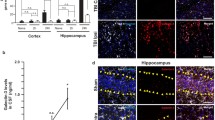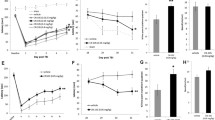Abstract
The femtomolar-acting eight-amino-acid peptide (NAP), derived from activity-dependent neuroprotective protein (ADNP), provides long-term protection against the deleterious effects of closed head injury (CHI) in mice. Fifteen minutes after injury, mice were divided into two groups, control and NAP-treated and a single subcutaneous injection of NAP or vehicle was administered. A third group served as sham-treated (not subjected to head trauma). Each mouse was assessed for its clinical function, using neurological severity score, at various time intervals following CHI, up to 30–45 d. Total cerebral cortex RNA was prepared from the site of injury of CHI mice, and from parallel regions in peptide-treated and sham brains. RNA was then reversed transcribed to yield radioactive cDNA preparations that were hybridized to Atlas array membranes containing 1200 cDNAs spots. Comparison of sham-treated individual mice showed differential expression levels of at least 15 mRNA species. Furthermore, results indicated that one of the genes that did not change among individuals but specifically increased after CHI and decreased after NAP treatment was the cell surface glycoprotein Mac-1 (CD11B antigen). Thus, Mac-1 is suggested as a marker for the long-term outcome of head injury and as a potential target for NAP protective actions.
Similar content being viewed by others
References
Arnaout M. A., Todd R. F., Dana N., Melamed J., Schlossman S. F., and Colten H. R. (1983) Inhibition of phagocytosis of complement C3- or immunoglobulin G-coated particles and of C3bi binding by monoclonal antibodies to a monocyte-granulocyte membrane glycoprotein (Mol). J. Clin. Invest. 72, 171–179.
Arvin B., Neville L. F., Barone F. C., and Feuerstein G. Z. (1995) Brain injury and inflammation. A putative role of TNF alpha. Ann. N.Y. Acad. Sci. 15, 62–71; discussion 98–99.
Bassan M., Zamostiano R., Davidson A., et al. (1999) Complete sequence of a novel protein containing a femtomolar-activity-dependent neuroprotective peptide. J. Neurochem. 72, 1283–1293.
Beni-Adani L., Gozes I., Cohen Y., et al. (2001) A peptide derived from activity-dependent neuroprotective protein (ADNP) ameliorates injury response in closed head injury in mice. J. Pharmacol. Exp. Ther. 296, 57–63.
Bell M. J., Kochanek P. M., Doughty L. A., et al. (1997) Interleukin-6 and interleukin-10 in cerebrospinal fluid after severe traumatic brain injury in children. J. Neurotrauma 14, 451–457.
Brenneman D. E. and Eiden L. E. (1986) Vasoactive intestinal peptide and electrical activity influence neuronal survival. Proc. Natl. Acad. Sci. USA 83, 1159–1162.
Chen Y., Constantini S., Trembovler V., Weinstock M., and Shohami E. (1996) An experimental model of closed head injury in mice: pathophysiology, histopathology, and cognitive deficits. J. Neurotrauma. 13, 557–568.
Chopp M., Zhang R. L., and Chen H. (1994) Postischemic administration of anti-Mac-1 antibody reduces ischemic cell damage after transient middle cerebral artery occlusion in rats. Stroke 25, 869–875; discussion 875–866.
Chopp M., Li Y., and Jiang N. (1996) Antibodies against adhesion molecules reduce apoptosis after transient middle serebral artery occlusion in rat brain. J. Cereb. Blood Flow Metab. 16, 578–584.
Coria F., Rubio I., and Bayon C. (1994) Alzheimer’s disease, beta-amyloidosis, and aging. Rev. Neurosci. 5, 275–292.
Diamond M. S., Garcia-Aguilar J., Bickford J. K., Corbi A. L., and Springer T. A. (1993) The I domain is a major recognition site on the leukocyte integrin Mac-1 (CD11b/CD18) for four distinct adhesion ligands. J. Cell Biol. 120, 1031–1043.
Engel S., Wehner H. D., and Meyermann R. (1996) Expression of microglial markers in the human CNS after closed head injury. Acta. Neurochir. Suppl. (Wien.) 66, 89–95.
Fan L., Young P.R., Barone F.C., Feuerstein G.Z., Smith D. H., and McIntosh T. K. (1996) Experimental brain injury induces differential expression of tumor necrosis factor-α mRNA in the CNS. Mol. Brain Res. 36, 287–291.
Feuerstein G.Z., Wang X., and Barone F.C. (1997) Inflammatory gene expression in cerebral ischemia and trauma. Potential new therapeutic targets. Ann. N.Y. Acad. Sci. 15, 179–193.
Gedye A., Beattie B. L., Tuokko H., Horton A., and Korsarek E. (1989) Severe head injury hastens age of onset of Alzheimer’s disease. J. Am. Geriatr. Soc. 37, 970–973.
Gozes I. and Brenneman D. E. (1989) VIP: molecular biology and neurobiological function. Mol. Neurobiol. 3, 201–236.
Gozes I., Fridkin M., Hill J. M., and Brenneman D. E. (1999) Pharmaceutical VIP: prospects and problems. Curr. Med. Chem. 6, 1019–1034.
Gozes I., Giladi E., Pinhasov A., Bardea A., and Brenneman D. E. (2000) Activity-dependent neurotrophic factor: intranasal administration of femtomolar-acting peptides improve performance in a watermaze. J. Pharmacol. Exp. Therap. 293, 1091–1098.
Holmin S. and Mathiesen T. (1999) Long-term intracerebral inflammatory response after experimental focal brain injury in rat. Neuroreport. 10, 1889–1891.
Hoshino S., Tamaoka A., Takahashi M., et al. (1998) Emergence of immunoreactivities for phosphorylated tau and amyloid-beta protein in chronic stage of fluid percussion injury in rat brain. Neuroreport. 9, 1879–1883.
Kita T., Liu L., Tanaka N., and Kinoshita Y. (1997) The expression of tumor necrosis factor-alpha in the rat brain after fluid percussive injury. Intl. J. Legal Med. 110, 305–311.
Kochanek P. M. and Hallenbeck J. M. (1992) Polymorphonuclear leukocytes and monocytes/macrophages in the pathogenesis of cerebral ischemia and stroke. Stroke 23, 1367–1379.
Kossmann T., Hans V., Imhof H. G., Trentz O., and Morganti-Kossmann M.C. (1996) Interleukin-6 released in human cerebrospinal fluid following traumatic brain injury may trigger nerve growth factor production in astrocytes. Brain Res. 713, 143–152.
Matsuo Y., Kihara T., and Ikeda M. (1995) Role of neutrophils in radical production during ischemia and reperfusion of the rat brain: affect of neutrophil depletion on extracellular ascorbyl radical formation. J. Cereb. Flow. Metab. 15, 941–947.
McIntosh T. K., Juhler M., and Wieloch T. (1998) Novel pharmacologic strategies in the treatment of experimental traumatic brain injury. J. Neurotrauma 15, 731–769.
Morganti-Kossmann M. C., Lenzlinger P. M., Hans V., et al. (1997) Production of cytokines following brain injury: beneficial and deleterious for the damaged tissue. Mol. Psychiatry 2, 133–136.
Nonaka M., Chen X. H., Pierce J. E., et al. (1999) Prolonged activation of NF-kappaB following traumatic brain injury in rats. J. Neurotrauma 16, 1023–1034.
Offen D., Sherki Y., Melamed E., Fridkin M., Brenneman D. E., and Gozes I. (2000) Vasoactive intestinal peptide (VIP) prevents neurotoxicity in neuronal cultures: relevance to neuroprotection in Parkinson’s disease. Brain Res. 854, 257–262.
Scherbel U., Raghupathi R., Nakamura M., et al. (1999) Differential acute and chronic responses of tumor necrosis factor-deficient mice to experimental brain injury. Proc. Natl. Acad. Sci. USA 96, 8721–8726
Shohami E., Novikov M., Bass R., Yamin A., and Gallily R. (1994) Closed head injury triggers early production of TNFα and IL-6 by brain tissue. J. Cereb. Blood Flow Metab. 14, 615–619.
Shohami E., Gallily R., Mechoulam R., Bass R., and Ben-Hur T. (1997) Cytokine production in the brain following closed head injury: dexanabinol (HU-211) is a novel TNF-α inhibitor and an effective neuroprotectant. J. Neuroimmunol. 72, 169–177.
Stahel P.F., Kariya K., Shohami E., Barnum S. R., Eugster H. P., Trentz O., Kossmann T., and Morganti-Kossmann M. C. (2000) Intracerebral complement C5a receptor (CD88) expression is regulated by TNF and lymphtoxin-α following closed head injury in mice. J. Neuroimmunol. 109, 164–172.
Stahel P. F., Shohami E., Younis F. M., et al. (2000) Experimental closed head injury: analysis of neurological outcome, blood-brain barrier dysfunction, intracranial neutrophil infiltration, and neuronal cell death in mice deficient in genes for pro-inflammatory cytokines. J. Cereb. Blood Flow Metab. 20, 369–380.
Steingart R. A., Solomon B., Brenneman D. E., Fridkin M., and Gozes I. (2000) VIP and peptides related to activity-dependent neurotrophic factor protect PC12 cells against oxidative stress. J. Mol. Neurosci. 15, 137–145.
Taupin V., Toulmond S., Serrano A., Benavides J., and Zavala F. (1993) Increase in IL-6, IL-1 and TNF levels in rat brain following traumatic lesion. Influence of pre- and post-traumatic treatment with Ro5 4864, a peripheral-type (p site) benzodiazepine ligand. J. Neuroimmunol. 42, 177–185.
Walzog B., Weinmann P., Jeblonski F., Scharffetter-Kochanek K., Bommert K., and Gaehtgens P. (1999) A role for beta (2) integrins (CD11/CD18) in the regulation of cytokine gene expression of polymorphonuclear neutrophils during the inflammatory response. FASEB J. 13, 1855–1865.
Whalen M. J., Carlos T. M., and Adelson P. D. (1998) Intreleukin-8 is in creased in CSF of children with severe traumatic brain injury. Crit. Care Med. 26, A85.
Whalen M. J., Carlos T. M., Clark R. S., and Kochanek P. M. (1999) An acute inflammatory response to the use of granulocyte colony-stimulating factor to prevent infections in patients with brain injury: what about the brain? Crit. Care Med. 27, 1014–1018.
Wright S. D., Rao P. E., Van Voorhis W. C., et al. (1983) Identification of the C3bi receptor of human monocytes and macrophages by using monoclonal antibodies. Proc. Natl. Acad. Sci. USA 80, 5699–5703.
Zamostiano R., Pinhasov A., Gelber E., et al. (2001) Cloning and characterization of the human activity-dependent neuroprotective protein. J. Biol. Chem. 276, 708–714.
Zemlyak I., Furman S., Brenneman D. E., and Gozes I. (2000) A novel peptide (NAP) prevents death in enriched neuronal cultures. Regulatory Peptides 96, 39–43.
Author information
Authors and Affiliations
Corresponding author
Rights and permissions
About this article
Cite this article
Romano, J., Beni-Adani, L., Nissenbaum, O.L. et al. A single administration of the peptide NAP induces long-term protective changes against the consequences of head injury. J Mol Neurosci 18, 37–45 (2002). https://doi.org/10.1385/JMN:18:1-2:37
Received:
Accepted:
Issue Date:
DOI: https://doi.org/10.1385/JMN:18:1-2:37




